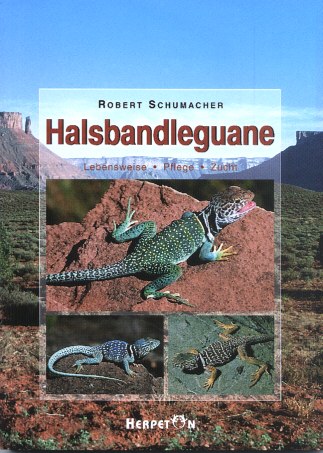Die kontinuierliche Zucht des Halsbandleguans Crotaphytus
collaris (SAY, 1823)
im Terrarium,
mit Hinweisen zur Unterartproblematik.
ROBERT
A. H. SCHUMACHER
Diese Arbeit wurde mit dem 2. Preis für herausragende
Nachzuchtergebnisse auf dem Fachgebiet der Herpetologie-
dem ALFRED- A. SCHMIDT PREIS 1994
von einer Jury ausgezeichnet.
Original in: Salamandra, Rheinbach, 30.9.1998, 34(3):
193-218
© 1998 Deutsche Gesellschaft für Herpetologie und
Terrarienkunde e.V. (DGHT)
Wenn Sie
einen kompletten Ausdruck dieser Arbeit wünschen, so wenden Sie sich bitte an
die Geschäftsstelle der Deutsche Gesellschaft für Herpetologie und
Terrarienkunde e.V. in Rheinbach.
Ich gebe hier zu Ihrer Information nur diese kurze Zusammenfassung des Inhalts
und im Anschluß eine kleine Auswahl weiterführender Literatur zu diesem Thema.
Abstract
Several
subspecies of the Collared lizard Crotaphytus collaris were kept over
eight years in indoor terraria where they bred regularly. Egg-laying and
hatching dates, partially to the 4th generation, were recorded for more than 70
clutches with over 300 hatchlings.
Beyond
precise data on husbandry, emphasis layed on the description of the conditions
for hibernation. A winter pause corresponds to the climatological conditions in
the biotope and is essential for successful breeding.
Each
reproductive female produces normally two (sometimes three, in young females
one) yearly clutches with 6-7 eggs each. Incubation lasts 50-55 days at
28-30°C. Juveniles can be raised in age groups without problems. Their
colouration differs strikingly from that of adults.
It is
urgently recommended to select mates for breeding groups from the same
subspecies. The crossbreeding of Crotaphytus collaris auriceps x Crotaphytus
collaris collaris produced abnormal offspring. This fact and the great
difference of colour patterns between subspecies suggest that Crotaphytus
collaris may perhaps split into several full species.
Key
words: Sauria: Crotaphytidae: Crotaphytus collaris, long term captive
breeding, habitat, climatic demands, diet composition.
Zusammenfassung
Die kontinuierliche Zucht mehrerer Unterarten
des Halsbandleguans (Crotaphytus collaris auriceps, C.c. baileyi und C.c.
collaris) während der achtjährigen Haltung in Zimmerterrarien wird
beschrieben. Die Ablage- und Schlupfdaten, teils bis zur F4 -Generation, werden
von mehr als 70 Gelegen und für über 300 geschlüpfte Jungtiere aufgeführt.
Aufbau und Einrichtung der Terrarien,
Futterangebot, Versorgung mit Vitaminen und Mineralstoffen sowie der
jahreszeitliche Haltungsrhythmus werden beschrieben. Ausführlich wird auf die
sehr wichtige Überwinterung eingegangen, die wesentlich für eine erfolgreiche
Zucht ist. Die fortpflanzungsfähigen Weibchen legen normalerweise zwei
(manchmal drei, bei jungen Weibchen ein) Gelege pro Jahr, mit je 6-7 Eiern. Sie
werden im Abstand von 30-40 Tagen abgesetzt und schlüpfen bei einer
Inkubationstemperatur von 28-30°C in 50-55 Tagen. Die Jungtiere unterscheiden
sich in der Färbung wesentlich von den Adulten. Ihre Aufzucht in Altersgruppen
erwies sich als problemlos.
Zuchtgruppen sollten unbedingt aus Tieren
der gleichen Unterart bestehen. Dies zeigte die Kreuzung von C.c. auriceps x
C.c. collaris, bei der die Bastarde massive Anomalien zeigten. Dies
sowie die teilweise recht bemerkenswerten Unterschiede der Farbmuster weist
darauf hin, daß Crotaphytus collaris eventuell in weitere Arten
aufzuspalten ist.
Schlagwörter: Sauria: Crotaphytidae: Crotaphytus
collaris, Nachzucht, Habitat, klimatische Ansprüche, Beutespektrum.
Wenn Sie umfangreiche Information zur
Haltung und Zucht von Halsbandleguanen suchen, erlaube ich mir, Sie auf mein im
Herbst 2002 erschienenes Buch Halsbandleguane hinzuweisen.
Weiterführende Schriften:
AXTELL, R. W. & R. R. MONTANUCCI (1977). Crotaphytus collaris
from the Eastern Sonoran Desert: Description of a Previously Unrecognized
Geographic Race.-Nat. Hist. Miscellanea, Chicago,201:1-8.
BAIRD, S. F. (1859). Reptiles of the
boundary. -U.S.-Mex. Bound. Surv., S.1-35, Tafel 1-41.
BANTA, B. H. (1960). Notes on the Feeding of the
Western Collared Lizard, Crotaphytus collaris baileyi Stejneger. -The
Wasmann Journal of Biology, Fall,18(2):309-311.
BLAIR, W. F. & A. P. BLAIR.
(1941). Foot habits of the collared lizard in nothestern Oklahoma. - American
Midl. Nat., 26:230-232.
DENBURGH J. & J. R. SLEVIN.
(1921). Preliminary Diagnoses of New Species of Reptiles from Islands in the
Gulf of California, Mexico. -Proceedings of the California Academy of Sciences,
San Francisco, XI(6):95-98.
FITCH, H. S. & W. W. TANNER.
(1951). Remarks concerning the systematics of the Collared Lizard (Crotaphytus
collaris). -Trans. Kansas Acad. Sci., 54(4):548-559.
FITCH, H. S. (1956). An ecological study
of the Collared Lizard (Crotaphytus collaris). -Univ. Kansas
Publ. Mus. Nat. Hist., Lawrence, 8(3):213-274.
HAMMERSON, G. A. (1986). Amphibians and
Reptiles in Colorado. -Colorado Division of Wildlife, Denver. 131 S.
HOLBROOK, J. E. (1836-1842). North American
Herpetology; or, a description of the reptiles inhabiting the United States. Vol.1-3
J. Dobson, Philadelphia.
INGRAM, W. & W. W. TANNER.
(1971). A taxonomic study of the Crotaphytus collaris between the Rio Grande and Colorado Rivers.-Brigham Young
Univ. Sci. Bull. Biol. Ser., Provo, 13(2):1-29.
JOHNSON, T. R. (1992). The Amphibians and
Reptiles of Missouri. -Missouri Department of Conservation, Jefferson City. 369
S.
KNOWLTON, G. F. & W. L. THOMAS.
(1936). Foot habits of Skull Valley lizards. -Copeia 1:64-66.
LEGLER J. M. & H. S. FITCH.
(1957). Observations on hibernation and nests of the Collared Lizard, Crotaphytus
collaris. -Copeia 1957(4):305-307.
MAC GUIRE, J. A. (1994). A
new species of collared lizard (Iguania: Crotaphytidae) from northeastern Baja
California, Mexico. -Herpetologica 50(4):438-450.
MONTANUCCI, R. R. (1971). Ecological and distributional
data on Crotaphytus reticulatus. (Sauria: Iguanidae).-Herpetologica 27:183-197.
MONTANUCCI, R. R. (1983). Natural Hybridization between
Two Species of Collared Lizards (Crotaphytus). -Copeia 1983(1):1-11.
SAY, T. (1823). In: Long`s
account of an expedition from Pittsburgh to the Rocky Mountains, performed in
the years 1819 and `20. H. C. Cory and I. Lea, Philadelphia. Vol.2:252.
SCHMIDT, K. P. (1922). The
amphibians and reptiles of Lower California and the neighboring islands. Bull.
Amer. Mus. Nat. Hist. 46:607-707.
SMITH, H. M. (1971). Handbook of lizards.
Lizards of the United States and of Canada. -5rd. ed. Comstock Publishing Co. Ithaca.
557 S.
SMITH, N. M. AND W.
W. TANNER. (1972). Two new subspecies of Crotaphytus.
(Sauria: Iguanidae). Reprints from Great Basin Naturalist. 32(1):25-34.
STEJNEGER, L. (1890). An annotated list of
reptiles and batrachians collected by Dr. C. Hart Merriam and Vernon Bailey on
the San Francisco Mountain Plateau and Desert of the Little Colorado River,
Arizona, with description of new species. -North Amer. Fauna. 3:103-118.
Verfasser: ROBERT A. H. SCHUMACHER,
Fröbelstraße 50, D 58454 Witten
Zurück: home
